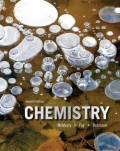
To write:The equilibrium constant expression Kcfor the given reaction
Concept Introduction:
The equilibrium constant (Kc) is defined as the ratio of the product of concentration of reaction products at equilibrium each raised to the particular stoichiometric coefficient present in balanced equation to the product of concentrations of the reactants at equilibrium each raised to their specific stoichiometric coefficient at a given temperature.
General reaction:
Where,
Answer to Problem 14.1P
Solution:
Explanation of Solution
To express the equilibrium constant expression Kcfor:
(c)
To write:The equilibrium constant expression Kcfor the given reaction
Concept Introduction:
The equilibrium constant (Kc) is defined as the ratio of the product of concentration of reaction products at equilibrium each raised to the particular stoichiometric coefficient present in balanced equation to the product of concentrations of the reactants at equilibrium each raised to their specific stoichiometric coefficient at a given temperature.
General reaction:
Where,
Answer to Problem 14.1P
Solution:
Explanation of Solution
To express the equilibrium constant expression Kcfor:
Want to see more full solutions like this?
Chapter 14 Solutions
EBK CHEMISTRY
 ChemistryChemistryISBN:9781305957404Author:Steven S. Zumdahl, Susan A. Zumdahl, Donald J. DeCostePublisher:Cengage Learning
ChemistryChemistryISBN:9781305957404Author:Steven S. Zumdahl, Susan A. Zumdahl, Donald J. DeCostePublisher:Cengage Learning ChemistryChemistryISBN:9781259911156Author:Raymond Chang Dr., Jason Overby ProfessorPublisher:McGraw-Hill Education
ChemistryChemistryISBN:9781259911156Author:Raymond Chang Dr., Jason Overby ProfessorPublisher:McGraw-Hill Education Principles of Instrumental AnalysisChemistryISBN:9781305577213Author:Douglas A. Skoog, F. James Holler, Stanley R. CrouchPublisher:Cengage Learning
Principles of Instrumental AnalysisChemistryISBN:9781305577213Author:Douglas A. Skoog, F. James Holler, Stanley R. CrouchPublisher:Cengage Learning Organic ChemistryChemistryISBN:9780078021558Author:Janice Gorzynski Smith Dr.Publisher:McGraw-Hill Education
Organic ChemistryChemistryISBN:9780078021558Author:Janice Gorzynski Smith Dr.Publisher:McGraw-Hill Education Chemistry: Principles and ReactionsChemistryISBN:9781305079373Author:William L. Masterton, Cecile N. HurleyPublisher:Cengage Learning
Chemistry: Principles and ReactionsChemistryISBN:9781305079373Author:William L. Masterton, Cecile N. HurleyPublisher:Cengage Learning Elementary Principles of Chemical Processes, Bind...ChemistryISBN:9781118431221Author:Richard M. Felder, Ronald W. Rousseau, Lisa G. BullardPublisher:WILEY
Elementary Principles of Chemical Processes, Bind...ChemistryISBN:9781118431221Author:Richard M. Felder, Ronald W. Rousseau, Lisa G. BullardPublisher:WILEY





